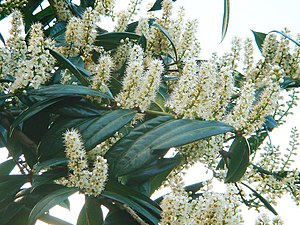Prunus laurocerasus
| Cherry Laurel | |
|---|---|
 | |
| Binomial: | Prunus laurocerasus |
| Family: | Rosaceae |
Prunus laurocerasus (Cherry-laurel or Laurel Cherry) is an evergreen shrub native to regions bordering the Black Sea in southwestern Asia and southeastern Europe, from Albania and Bulgaria east through Turkey to the Caucasus Mountains and northern Iran.[1][2]
Description
[edit | edit source]It is an evergreen shrub or small tree, growing to 5-15 m tall, rarely to 18 m tall, with a trunk up to 60 cm diameter. The leaves are dark green, leathery, shiny, (5–)10–25(–30) cm long and 4-10 cm broad, with a finely serrated margin. The flower buds appear in early spring and open in early summer in erect 7-15 cm racemes of 30–40 flowers, each flower 1 cm diameter, with five creamy-white petals and numerous yellowish stamens. The fruit is a small cherry 1-2 cm diameter, turning black when ripe in early autumn.[3][4]

Prunus laurocerasus is often called 'laurel' because of the similarity of foliage and appearance to the true laurel, Laurus nobilis. However, the two plants are not related.
Growing Conditions
[edit | edit source]Varieties
[edit | edit source]Over 40 cultivars have been selected, including:[5]
- 'Aureovariegata' – variegated, leaves with a yellow margin.
- 'Magnifolia' – vigorous, with large leaves up to 30 cm long and 11 cm broad.
- 'Otto Luyken' – semi-dwarf, with small leaves 10 cm long and 2–3 cm broad.
- 'Zabeliana' – selected for winter cold tolerance.
Uses
[edit | edit source]Prunus laurocerasus has been widely planted as an ornamental plant in temperate regions worldwide, and has become naturalised widely in some areas. It is often used for screening, and also as a mass landscape and ground cover plant. Most forms are tough shrubs that can cope with difficult growing conditions (including shaded and dry conditions), and which respond well to pruning. The foliage is also used for cut greenery in floristry.
Unlike the rest of the plant, which is poisonous, the cherries are edible, although rather bland and with a somewhat astringent flavour compared to the fruit of apricots, true cherries, plums, and peaches, to which it is related. The seeds contained within the berries are poisonous like the rest of the plant, containing cyanogenic glycosides and amygdalin.[6] This chemical composition is what gives the smell of almonds when the leaves are crushed.
Laurel water, a distillation made from the plant, has a pharmacological usage.
Maintenance
[edit | edit source]In some regions such as the Pacific Northwest of the United States, this species is an invasive plant. Its rapid growth, coupled with its evergreen habit and its tolerance of drought and shade, often allow it to out-compete and kill off native plant species. This reduces the overall diversity of ecosystems and impacts other plants and animals that live there negatively. It is also difficult to control once it has naturalised, because some species of birds eat the fruits and spread the seeds in their droppings.
Propagation
[edit | edit source]Harvest
[edit | edit source]Pests and Diseases
[edit | edit source]References
[edit | edit source]- ↑ Euro+Med Plantbase Project: Prunus laurocerasus
- ↑ Germplasm Resources Information Network: Prunus laurocerasus
- ↑ Rushforth, K. (1999). Trees of Britain and Europe. Collins ISBN 0-00-220013-9.
- ↑ Flora of NW Europe: Prunus laurocerasus
- ↑ Huxley, A., ed. (1992). New RHS Dictionary of Gardening. Macmillan ISBN 0-333-47494-5.
- ↑ Poisonous Plants: Prunus Laurocerasus
| Wikiversity is collecting bloom time data for Prunus laurocerasus on the Bloom Clock |
- Book:Horticulture/Finder/Types/Trees, Small
- Book:Horticulture/Finder/Types/Shrubs, Large
- Book:Horticulture/Finder/Types/Shrubs, Small
- Book:Horticulture/Finder/Types/Evergreens
- Book:Horticulture/Finder/Seasons/Spring
- Book:Horticulture/Finder/Conditions/Part Shade
- Book:Horticulture/Finder/Conditions/Full Sun
- Book:Horticulture/Finder/Special/Quality Nectar Source
- Book:Horticulture/Finder/Resistance/Deer
- Book:Horticulture/Finder/Invasive/North America
- Book:Horticulture/Finder/Native/Europe
- Book:Horticulture/Finder/Flowers/White
- Book:Horticulture/Finder/Toxicity/Livestock or Pets